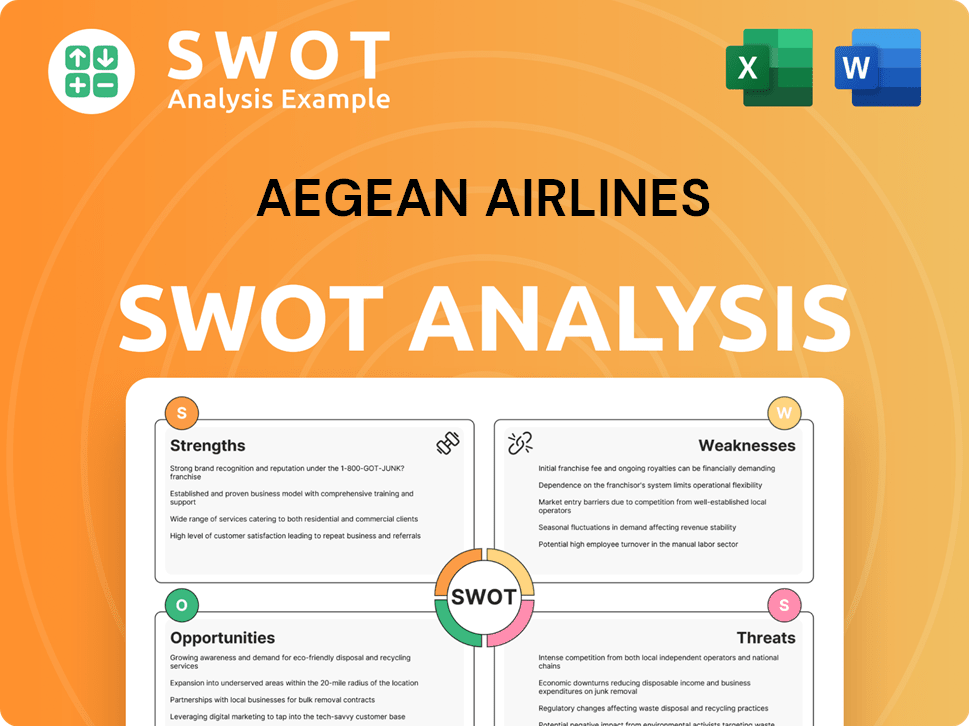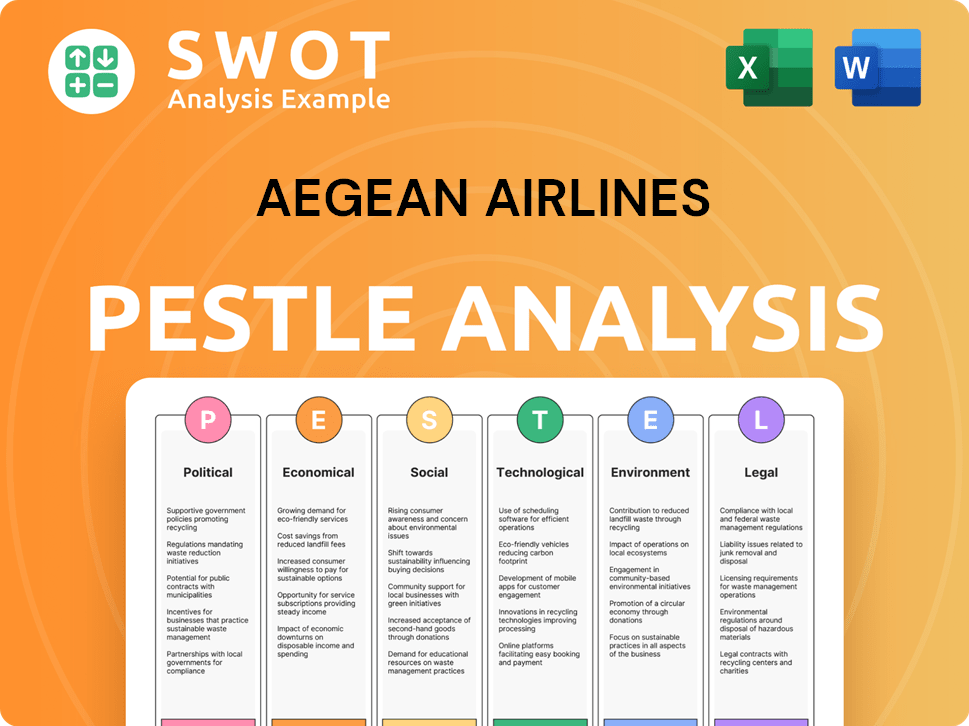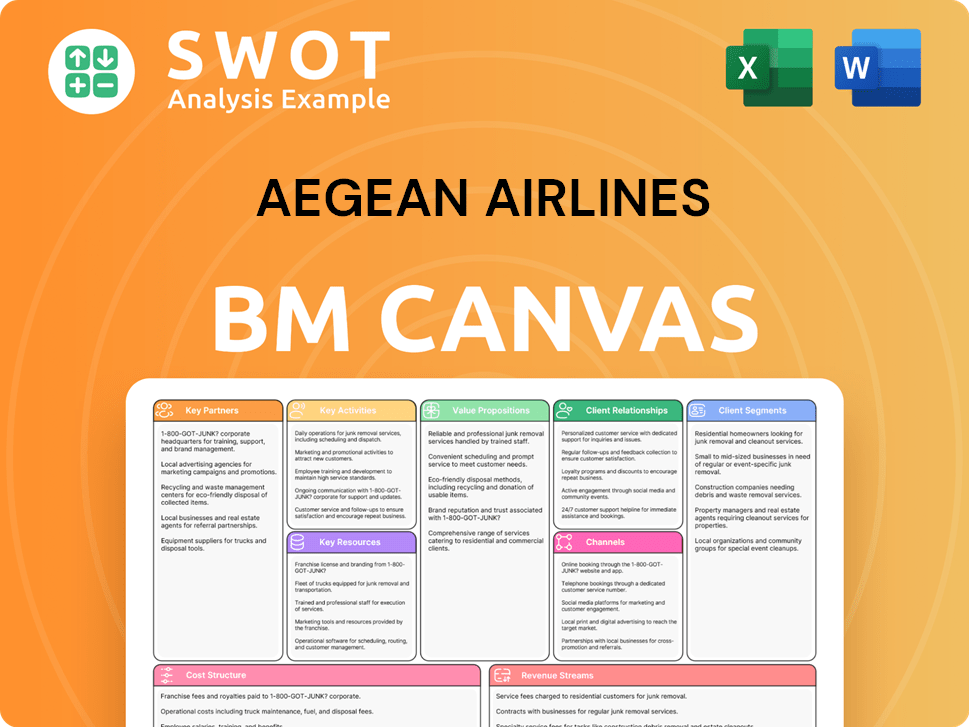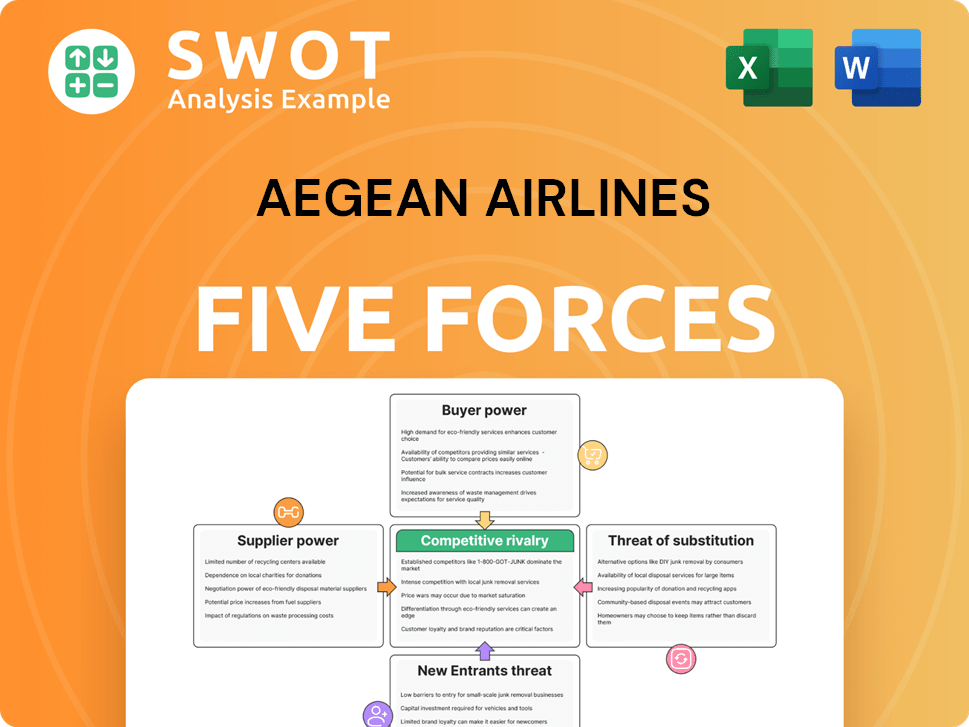Aegean Airlines Bundle
How Did Aegean Airlines Become Greece's Leading Carrier?
From its humble beginnings in 1987, Aegean Airlines has soared to become Greece's largest airline, a testament to its strategic vision and resilience. The Aegean Airlines SWOT Analysis reveals the key factors behind its remarkable journey. Its merger with Olympic Air in 2013 was a pivotal moment, reshaping the Greek aviation market and solidifying its dominance.

This brief history of Aegean Airlines explores its early years as Aegean Aviation, its transformation into a scheduled passenger airline, and its expansion across Europe, the Middle East, and Africa. Learn about the significant events, including mergers and acquisitions, that have shaped this Greek airline's trajectory. Discover how Aegean Airlines has navigated challenges and achieved remarkable passenger growth, becoming a key player in the airline industry.
What is the Aegean Airlines Founding Story?
The Aegean Airlines history began in 1987. Initially, it was established as Aegean Aviation. This marked the start of a journey that would transform it into a prominent Greek airline.
The early years of Aegean Airlines company focused on air taxi and VIP services. This was a strategic move to meet the demand for private air travel in Greece. The company aimed to fill a gap in the market not fully served by the existing national carrier.
The transition from Aegean Aviation to Aegean Airlines signified a major shift. This change set the stage for its expansion into scheduled passenger services. This strategic move was influenced by the economic environment in Greece, which presented opportunities for new entrants in the airline market.
Aegean Aviation started in 1987, offering air taxi and VIP services before evolving into Aegean Airlines.
- The company initially addressed the need for flexible, private air travel in Greece.
- The shift to scheduled passenger services was a strategic response to market opportunities.
- The early business model focused on on-demand flights, providing a personalized travel experience.
- The transformation was influenced by the economic conditions in Greece, opening doors for new airline entrants.
Aegean Airlines SWOT Analysis
- Complete SWOT Breakdown
- Fully Customizable
- Editable in Excel & Word
- Professional Formatting
- Investor-Ready Format

What Drove the Early Growth of Aegean Airlines?
The early growth and expansion of Aegean Airlines marked a pivotal period in its history. Officially launching scheduled passenger operations in May 1999, the Greek airline quickly transitioned from its air taxi service origins. Initially, the focus was on domestic routes, connecting major cities within Greece. This strategy aimed to offer a high-quality alternative in the market.
In its early years, Aegean Airlines concentrated on building a strong presence in the Greek domestic market. This involved establishing routes to major cities like Athens, Thessaloniki, and Heraklion. The company aimed to provide a superior customer experience compared to the existing competitor, emphasizing both service quality and operational efficiency. This focus laid the groundwork for future expansion.
Rapid expansion of both the fleet and route network characterized the early growth phase of the Aegean Airlines company. By 2005, the airline had already established itself as a significant player in the Greek domestic market. This period saw continuous investment in fleet modernization and expansion, with the airline consistently adding new, more fuel-efficient aircraft to its operations.
A significant milestone for Aegean Airlines history was joining the Star Alliance in 2010. This strategic move significantly boosted its international reach and connectivity. This alliance allowed the airline to offer seamless travel to a vast network of destinations globally through its partners. This integration was crucial for its international expansion.
The merger with Olympic Air in 2013 reshaped the Greek aviation landscape. After an initial attempt was blocked, the merger created a stronger, more competitive Greek airline. The combined entity gained a dominant market share in domestic routes and enhanced its presence in international markets. This consolidation was a key event for the airline.
Aegean Airlines PESTLE Analysis
- Covers All 6 PESTLE Categories
- No Research Needed – Save Hours of Work
- Built by Experts, Trusted by Consultants
- Instant Download, Ready to Use
- 100% Editable, Fully Customizable

What are the key Milestones in Aegean Airlines history?
The Aegean Airlines company has achieved several significant milestones throughout its history, solidifying its position as a leading Greek airline. These achievements showcase the airline's growth and resilience in a competitive market.
| Year | Milestone |
|---|---|
| 1999 | Aegean Airlines begins operations as a Greek airline, initially focusing on domestic routes. |
| 2005 | Aegean Airlines becomes a member of Star Alliance, expanding its global reach through partnerships. |
| 2013 | Aegean Airlines merges with Olympic Air, consolidating its dominance in the Greek aviation market. |
| 2019 | Aegean Airlines celebrates its 20th anniversary, marking two decades of service and expansion. |
| 2024 | Aegean Airlines continues to receive awards, including the Skytrax World Airline Award for Best Regional Airline in Europe. |
Throughout its history, Aegean Airlines has consistently focused on innovation to enhance its services and operational efficiency. This includes fleet modernization and the implementation of advanced technologies.
Aegean Airlines has continuously invested in modern aircraft, including significant orders for the Airbus A320neo family. These new aircraft enhance fuel efficiency and reduce the airline's environmental impact.
The airline has been recognized for its high-quality service, consistently earning awards. This commitment to service excellence has helped Aegean Airlines maintain a strong reputation.
Aegean Airlines has expanded its route network significantly over the years, connecting Athens and other Greek cities with destinations across Europe and beyond. This expansion has supported its growth.
The company has integrated advanced technologies in its operations, including online booking systems and digital services. These advancements improve the passenger experience.
Aegean Airlines has implemented strategies to improve operational efficiency, including fuel-saving measures and optimized flight schedules. These initiatives contribute to cost savings.
The merger with Olympic Air was a strategic move to consolidate its position in the market. This has allowed for better resource allocation.
Despite its successes, Aegean Airlines has faced several challenges, including economic downturns and global crises. The company's ability to adapt has been crucial.
The prolonged economic crisis in Greece significantly impacted air travel demand and consumer spending. This required cost-cutting and efficiency measures.
The initial blocking of the merger with Olympic Air by the European Commission in 2011 presented a significant hurdle. The eventual approval required revised commitments.
The COVID-19 pandemic led to a drastic reduction in air travel. Aegean Airlines responded with health protocols and network adjustments.
Maintaining operational efficiency while managing costs and adapting to market changes has been a continuous challenge. The company has had to adapt quickly.
Fluctuations in fuel prices and currency exchange rates have created financial pressures. These external factors require careful financial planning.
Changes in aviation regulations and safety standards require ongoing compliance and investment. The airline must stay updated with evolving rules.
Aegean Airlines Business Model Canvas
- Complete 9-Block Business Model Canvas
- Effortlessly Communicate Your Business Strategy
- Investor-Ready BMC Format
- 100% Editable and Customizable
- Clear and Structured Layout

What is the Timeline of Key Events for Aegean Airlines?
The Aegean Airlines history is marked by significant milestones, starting with its founding in 1987 as Aegean Aviation, offering air taxi and VIP services. In 1999, it initiated scheduled passenger operations, and by 2005, it received the ERA Gold Award. A major step was taken in 2010 when Aegean Airlines joined Star Alliance, followed by the merger with Olympic Air in 2013. The airline consistently received accolades, including the Best Regional Airline in Europe from Skytrax from 2014 to 2018 and again in 2024. A substantial order for new Airbus A320neo family aircraft was placed in 2018. The company navigated the COVID-19 pandemic between 2020 and 2022, adapting operations and seeking financial aid.
| Year | Key Event |
|---|---|
| 1987 | Aegean Aviation is founded, providing air taxi and VIP services. |
| 1999 | Aegean Airlines begins scheduled passenger operations. |
| 2005 | Aegean Airlines is awarded the ERA Gold Award. |
| 2010 | Aegean Airlines becomes a Star Alliance member. |
| 2013 | Merger with Olympic Air is completed. |
| 2014-2018 | Recognized as the Best Regional Airline in Europe by Skytrax. |
| 2018 | Orders up to 42 Airbus A320neo family aircraft. |
| 2020-2022 | Navigates the COVID-19 pandemic, adapting operations. |
| 2024 | Recognized as the Best Regional Airline in Europe by Skytrax. |
Aegean Airlines is focused on modernizing its fleet. The delivery of new Airbus A320neo family aircraft is expected to continue through 2025 and beyond. This will help enhance operational efficiency and reduce environmental impact. The airline's commitment to fleet renewal is a key part of its strategy.
Aegean Airlines plans to strengthen its position in existing markets. It is also exploring expansion opportunities to new strategic destinations. These efforts are particularly focused on destinations that support and enhance Greece's tourism appeal. This expansion aims to grow its route network.
The company is working on enhancing its digital services. This includes improvements to its loyalty programs to boost customer experience and retention. These initiatives are designed to create a better experience for travelers. They also aim to increase customer loyalty.
Aegean Airlines is taking into account industry trends like the rising demand for sustainable travel. Technological advancements in aviation are also influencing its future direction. The airline is committed to providing high-quality service. It is also focused on expanding its network, staying true to its original goal of connecting Greece to the world.
Aegean Airlines Porter's Five Forces Analysis
- Covers All 5 Competitive Forces in Detail
- Structured for Consultants, Students, and Founders
- 100% Editable in Microsoft Word & Excel
- Instant Digital Download – Use Immediately
- Compatible with Mac & PC – Fully Unlocked

Related Blogs
- What is Competitive Landscape of Aegean Airlines Company?
- What is Growth Strategy and Future Prospects of Aegean Airlines Company?
- How Does Aegean Airlines Company Work?
- What is Sales and Marketing Strategy of Aegean Airlines Company?
- What is Brief History of Aegean Airlines Company?
- Who Owns Aegean Airlines Company?
- What is Customer Demographics and Target Market of Aegean Airlines Company?
Disclaimer
All information, articles, and product details provided on this website are for general informational and educational purposes only. We do not claim any ownership over, nor do we intend to infringe upon, any trademarks, copyrights, logos, brand names, or other intellectual property mentioned or depicted on this site. Such intellectual property remains the property of its respective owners, and any references here are made solely for identification or informational purposes, without implying any affiliation, endorsement, or partnership.
We make no representations or warranties, express or implied, regarding the accuracy, completeness, or suitability of any content or products presented. Nothing on this website should be construed as legal, tax, investment, financial, medical, or other professional advice. In addition, no part of this site—including articles or product references—constitutes a solicitation, recommendation, endorsement, advertisement, or offer to buy or sell any securities, franchises, or other financial instruments, particularly in jurisdictions where such activity would be unlawful.
All content is of a general nature and may not address the specific circumstances of any individual or entity. It is not a substitute for professional advice or services. Any actions you take based on the information provided here are strictly at your own risk. You accept full responsibility for any decisions or outcomes arising from your use of this website and agree to release us from any liability in connection with your use of, or reliance upon, the content or products found herein.